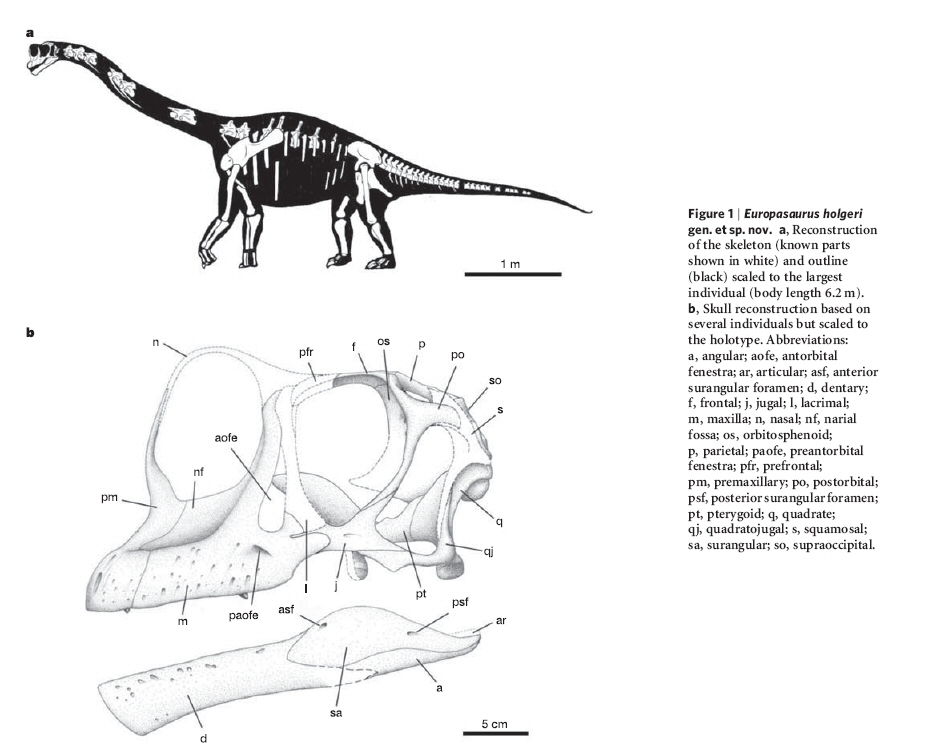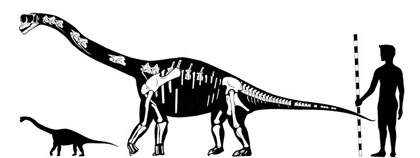First of all, sorry for bombarding y'all with such a long and scientific title 
A new 'Letter to nature' is out on a teriffic dinosaur find from Germany. Short version: Honey, I shrunk the dinosaurs
full text access here (for those lucky ones who have it): full
and here's the link to the 'news' article on the find:
http://www.nature.com/news/2006/060605/full/060605-8.html
a short quote from the paper by Sander, Mateus, Laven & Knötschke:


A new 'Letter to nature' is out on a teriffic dinosaur find from Germany. Short version: Honey, I shrunk the dinosaurs

full text access here (for those lucky ones who have it): full
and here's the link to the 'news' article on the find:
http://www.nature.com/news/2006/060605/full/060605-8.html
Tiny dino discovered
German fossil was a dwarf version of the largest dinosaurs.
Michael Hopkin
Dinosaur researcher Nils Knötschke holds up his reconstruction of the creature's skull.
© Dinopark Munchehagen
Sauropod dinosaurs were the biggest animals ever to walk the earth. But palaeontologists in Germany seem to have dug up the runt of the litter.
The new species, Europasaurus holgeri, measured barely more than 6 metres from snout to tail. In comparison, its more famous relative Diplodocus grew to a mighty 27 metres.
Researchers led by Martin Sander of the University of Bonn unearthed the remains of at least 10 individual dinosaurs at a quarry near Hannover in northern Germany. They unveil the find in this week's Nature1.
Many sauropods were huge, with long necks that allowed them to graze over a tremendous area. When they found the bones, Sander's team thought that they were from juvenile dinosaurs. But examination revealed that the bones had a structure like those of adult dinosaurs, and that in the largest dinosaur, which measured 6.2 metres, the bones were fully developed.
The area where the bones were found would have been largely flooded when the dinosaurs lived there, around 150 million years ago, the researchers add. Food might have been scarce on the islands the dinosaurs lived on, favouring the evolution of smaller reptiles.
Similar, more recent, examples of such island dwarfing have been seen on the Indonesian island of Flores, which until a few thousand years ago was home to species such as dwarf elephants and Homo floresiensis, a tiny human.
Although big by human standards, adult and young E. holgeri (both pictured) were positively pet-sized in relation to other sauropods.
© Octavio Mateus, Museu da Lourinha
Evolutionists think that dwarf species are more likely to evolve on islands because populations there tend to be smaller and genetically isolated, meaning that species can rapidly become specialized.
"The little dinosaurs must have lived on one of the large islands around the Lower Saxony basin," Sander and his team write. "This suggests that it is an island dwarf species that evolved through a decrease in growth rate from its larger ancestor."
a short quote from the paper by Sander, Mateus, Laven & Knötschke:
Palaeogeography8 suggests insular dwarfing as the explanation for
the diminutive body size of Europasaurus. The largest palaeo-islands
surrounding the locality in the Lower Saxony basin had areas of
,200,000 km2 (calculated from ref. 8). Such islands would not have
been able to support large-bodied sauropods. The ancestor of
Europasaurus would have dwarfed rapidly on immigrating to the
island, or as a response to shrinking land masses caused by rising sea
levels.







